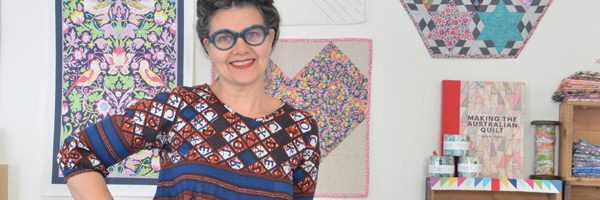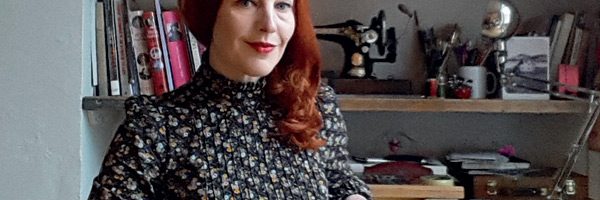
In the Studio with Michelle McKillop
The first quilt I ever participated in was a hexagon quilt for a fundraiser when I was 10 years old in Girl Guides. I thought it was the most beautiful thing I’d ever seen. I did my first quilting class as a young mum in 1992 and knew I had found my passion in life.
Over the years, Michelle McKillop has learnt and practised many crafts including knitting, cross stitch, painting and mixed media. “I took an art therapy class for many years and find art journalling and mixed media a really expressive, cathartic process,” she reveals. Michelle’s style is traditional with a modern, eclectic twist. “I believe that all this accumulated knowledge has enhanced my quilting” she says. Michelle enjoys needleturn appliqué and finds machine piecing a meditative process. She practised fine arts painting for several years in the early 2000s and claims the art theory gave her the confidence to draw and sketch, or to simply “follow the line”.
Around this time she was gifted a year-long class in creative writing. “It was a lot of fun and I learnt about describing verbal pictures and ‘show but don’t tell’. I like to think I tell stories now with fabric.”
Make your own Picture Perfect Bag with Minki Kim’s pattern
Michelle and her husband purchased their first house in Melbourne’s outer east during the 1991 financial recession. It had five bedrooms and at the time they had two children and a third on the way. That unused fifth bedroom eventually became Michelle’s studio. “I was pretty lucky to have that space at a time when my other quilting friends with children were working at their kitchen tables,” she says.
IKEA furniture plays an important role in Michelle’s sewing studio, as with many other quilters. Her “enormous” fabric stash is organised by colour in old post office oak cabinets that her husband rescued from a dumpster. She also has a striped fabric stash, a neutral stash and a large stash of fabric cuts over 2m. She keeps her threads handy in a drawer next to her sewing machine and the tools she uses regularly live in baskets. “Besides my IKEA units, my studio is a mish-mash of upcycled and handmade furniture,” she reveals. “I cut a hole in an old desk, attached a sewing machine lift and painted it bright pink, and my husband built my 2sqm cutting table from old floor boards. I love how these pieces of furniture have a story.”
However Michelle’s quilting process is not confined to her studio. She has “a very large free-standing bench in my kitchen which I love to use for hand-basting. I usually put a CD on and baste two or three quilts in an afternoon.” At the beginning of this year Michelle had accumulated more than 40 quilt tops, all awaiting quilting. It is now June (at the time of writing) and “with a concerted effort I’ve whittled that down to only 20” she enthuses.
Make these sweet sewing accessories by Michelle Ridgway
Michelle works on two sewing machines, both Pfaffs. “I have a top-of-the-line Quilt Expressions 4.2 that I bought two years ago, and my trusty 24-year-old Hobbymatic that still sews a beautiful straight stitch. I really enjoy hand-quilting with perle cotton — it gives a lovely patina to a quilt and is relatively quick,” she adds.
When her youngest started school in 2000, Michelle began teaching at local quilt stores and for the Janome company. “I had been doing quilt commissions for some years and it just seemed a natural progression,” she says. “I started designing almost as soon as I began quilting. The first quilt I ever made was a Double Irish Chain and the class sample was made of four very quiet prints, however I also used a very large, loud, black and red floral. I was always asking myself ‘what if…’ and changing things around.”
Michelle’s design process is inspired by play. “I explain to my students that I design by osmosis! I am strongly influenced by mood and colour and the changing seasons affect my work. I feel that good design requires good observation skills, discipline in daily practice and being totally immersed in the creative flow.”
Michelle began publishing her own patterns around 2008 and shortly after she started teaching at Amitie Textiles. “It was such a great experience and my style was very compatible with the whole Amitie vibe,” she recalls. In 2016 she was invited to become a designer for the Jen Kingwell Collective and her first patterns, Dreamweaver and Spindrift, were released at Spring Market (USA) in May, 2017.
“It is a pleasure and a privilege to be a part of such a vibrant, creative team with Jen, Lucy and Louise,” says Michelle. “I think anyone who works in a creative field is a bit like a tuning fork, as the world within and without influences their work. When sewing and designing I have this idiosyncrasy that the music I listen to has to be compatible with the quilt I’m stitching. So if I’m making a quilt with a ‘spring’ feel I’ll be listening to something like Enya, or if my quilt is ‘loud’ or ‘graphic’ it’ll be jazz or Robbie Williams. The entire design process is a strange beast,” she continues. “I have either a dozen ideas at once or I have none. I love the flow moments where you are so totally absorbed in the work that time passes unnoticed. If you really listen to your quilt it will tell you where it needs to go.”
Recreate a vintage needleturned applique sampler quilt
They say it takes 10,000 hours of practice to hone your craft and develop your style. As Michelle has made more than 700 quilts in 26 years, one might say she has reached and surpassed this milestone!
Michelle’s Tips
1 Your own studio space is great, but a corner of your bedroom or laundry is terrific with some wall shelving and a desk. I like project boxes to contain quilts on the go where I put all the fabrics, pattern, notes and notions for a single project.
2 It is important to learn all the techniques thoroughly before you break them; quilting is a hands-on craft and the more we practise, the better we get.
3 Always, always match your thread content to your fabric content: cotton fabric + cotton thread. Polyester thread is a ‘plastic’ and much stronger than cotton or linen fabrics and over time it will slice through the seams on your quilt.
“I raised my children to do what they love and to love what they do. If you don’t enjoy one technique then find another way to do things. This is your leisure time and possibly the legacy you will leave behind; let the love of what you do be visible in each stitch.”





